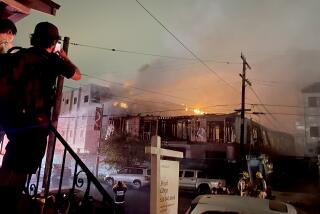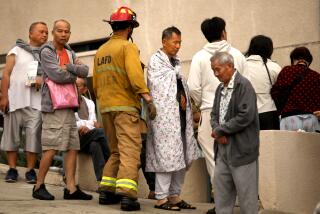Fire in 2-Bedroom Van Nuys Dwelling Leaves 11 Homeless
An overloaded electrical outlet apparently set fire to a two-bedroom house in Van Nuys on Tuesday, the Los Angeles Fire Department reported, displacing at least 11 people and prompting authorities to warn against the dangers of overcrowded dwellings.
Red Cross officials said that as many as 14 people may have been living in the house.
“For a small single dwelling of this size, that’s a lot of people,” Fire Department spokesman Phil Weireter said. “It can be dangerous because houses like that are not built for that many people.
“It’s happening more often in Los Angeles,” Weireter said, referring to fires displacing large numbers of people from single-family residences. He attributed the rise to the recession and a lack of affordable housing, saying fires in crowded dwellings typically occur in low-income areas of the city.
Eleven people were left homeless after a five-bedroom duplex they shared in the 900 block of Norton Avenue erupted in flames in the Mid-City area March 15, killing Martha Held, 66, and a cat, officials said.
In Tuesday’s Van Nuys blaze, the fire apparently started in a electrical outlet in a front bedroom at 6452 Fulton Ave., originally a two-bedroom house that included an added room, possibly created by converting a garage into a bedroom, Weireter said.
“There was the possibility of substandard wiring . . . and that there were too many electrical cords in an outlet,” he said. The blaze caused an estimated $140,000 damage to the structure and contents.
Nearly three dozen firefighters turned out to fight the 8:06 a.m. blaze.
Flames engulfed the main house, causing smoke and water damage to a rear bedroom area and leaving a third room next to a covered carport virtually unscathed. Burned belongings, including clothes, bed frames and mattresses, cluttered the front lawn Tuesday morning.
Residents of the home said they were awakened by the smell of smoke.
“I smelled the fire and I started to choke,” said Rigoberto Fernandes, who had been sleeping in a front bedroom. “We didn’t think anything like this could happen.”
Fourteen people from one extended family lived together in the house, said Peggy Voight, area supervisor of emergency services for the American Red Cross Los Angeles Chapter.
Voight said those displaced would be provided with hotel rooms for the next several days and emergency supplies of food and clothing, courtesy of the Red Cross. She said her organization would also help the fire victims relocate if needed.
Aiding extended families, left homeless due to fires and other disasters, is not uncommon in Pacoima, Sun Valley, the city of San Fernando and parts of Reseda, where there are large numbers of Latinos, who for cultural and financial reasons choose to live in extended families, Voight said.
Voight’s sentiments were echoed by Oscar Andrade, executive director of El Rescate, a nonprofit organization based in the Pico Union area that provides legal, social and community development services to Central Americans living in Los Angeles.
“When you have one or two family members who are the only ones working, and the extended family is large, what are you going to do?” Andrade said. “Put them on the streets or provide them with a place where they can at least sleep.”
Andrade said that unemployment rates and overpopulation in some areas of the San Fernando Valley are following the same trends that exist in the Pico Union area.
“People have to juggle whether they’re going to spend their money on food or rent,” Andrade said. “They’re forced to live in such conditions because of the poverty.”
Bill King, chief building mechanical inspector for the Van Nuys region of the Los Angeles Department of Building of Safety, said that the city’s building code calls for a minimum of 300 square feet for each person living in a dwelling in order to meet occupancy and exit requirements. But, King said, “It’s very difficult to enforce.”
More to Read
Sign up for Essential California
The most important California stories and recommendations in your inbox every morning.
You may occasionally receive promotional content from the Los Angeles Times.










